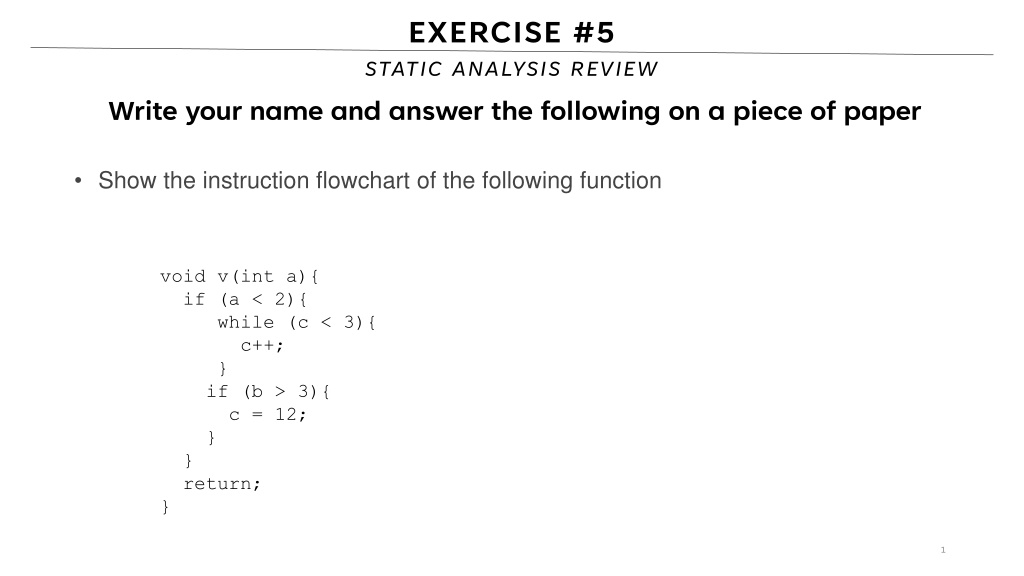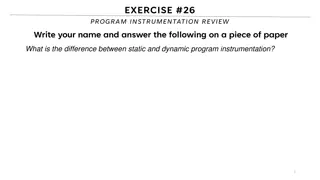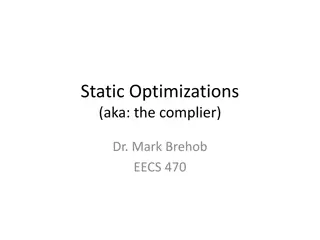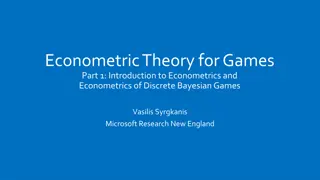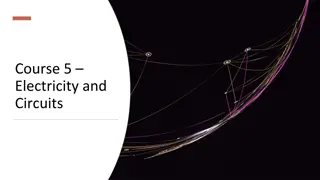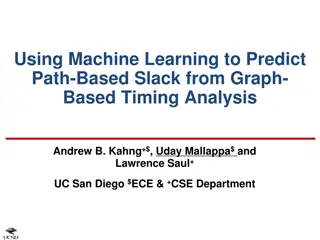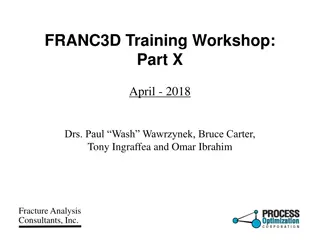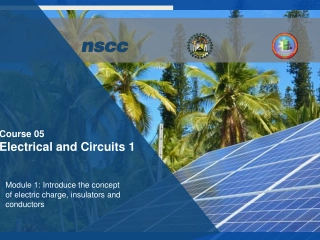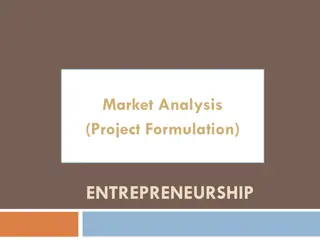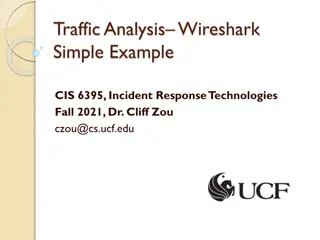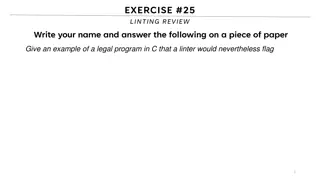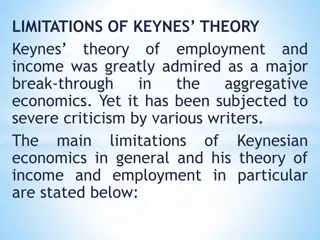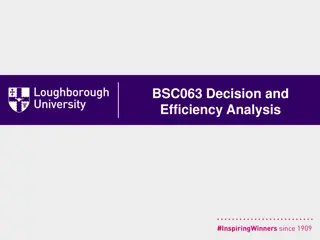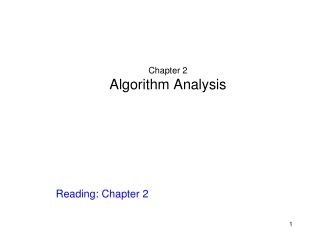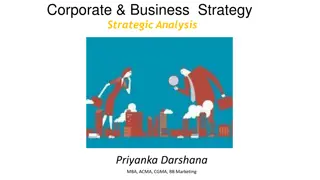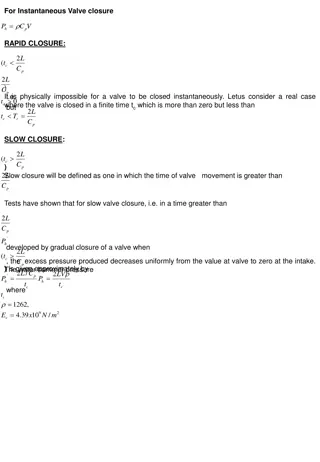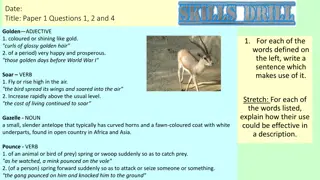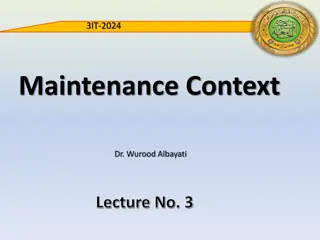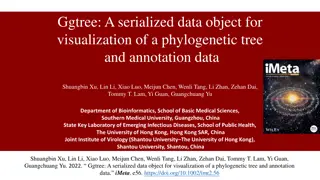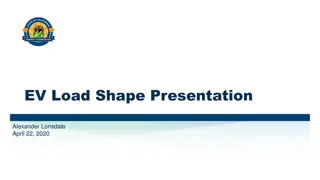Static Analysis Techniques Overview
Explore static analysis techniques such as syntactic analysis, dataflow analysis, and model checking. Understand the concept of basic blocks in static analysis and their boundaries. Dive into the opportunities provided by static analysis in summarizing program behavior without executing it.
Download Presentation

Please find below an Image/Link to download the presentation.
The content on the website is provided AS IS for your information and personal use only. It may not be sold, licensed, or shared on other websites without obtaining consent from the author. Download presentation by click this link. If you encounter any issues during the download, it is possible that the publisher has removed the file from their server.
E N D
Presentation Transcript
EXERCISE #5 STATIC ANALYSIS REVIEW Write your name and answer the following on a piece of paper Show the instruction flowchart of the following function void v(int a){ if (a < 2){ while (c < 3){ c++; } if (b > 3){ c = 12; } } return; } 1
ADMINISTRIVIA AND ANNOUNCEMENTS
CONTROL FLOW GRAPHS EECS 677: Software Security Evaluation Drew Davidson
4 CLASS PROGRESS OVERVIEWED TWO ANALYSIS APPROACHES: - DYNAMIC ANALYSIS: ANALYSIS THAT USES A RUN OF THE PROGRAM - STATIC ANALYSIS: ANALYSIS WITHOUT RUNNING THE PROGRAM
5 CONTINUE TO EXPLORE STATIC ANALYSIS CLASS PROGRESS LOOKINTOCONCRETEFORMSOF STATIC ANALYSIS - Particularly interested in dataflow analysis for now - Building up the underlying abstractions / techniques to perform such analysis
6 OPPORTUNITIES OF STATIC ANALYSIS CLASS PROGRESS FINITE ABSTRACTIONSOF UNBOUNDED STATE SPACE - Unnecessary to supply a given program input - Summarize the behavior of the program under ANY input
7 LAST TIME: STATIC ANALYSIS REVIEW: STATIC ANALYSIS MENTIONEDSOMESTATICANALYSIS TECHNIQUES - Syntactic Analysis - Dataflow Analysis - Model Checking STARTED BUILDINGA FUNDAMENTAL UNITOF STATIC ANALYSIS: THE BASIC BLOCK - Sequence of code that executes sequentially
8 BASIC BLOCKS BOUNDARIES REVIEW: STATIC ANALYSIS TWO DISTINGUISHED INSTRUCTIONS IN A BLOCK (MAY BE THE SAME INSTRUCTION) Leader: An instruction that begins the block Terminator: An instruction that ends the block
9 BASIC BLOCKS BOUNDARIES REVIEW: STATIC ANALYSIS TWO DISTINGUISHED INSTRUCTIONS IN A BLOCK (MAY BE THE SAME INSTRUCTION) Leader: An instruction that begins the block The first instruction in the procedure The target of a jump The instruction after an terminator Terminator: An instruction that ends the block The last instruction of the procedure A jump (ifz, goto) A call (We ll use a special LINK edge)
10 BASIC BLOCKS EXAMPLE STATIC ANALYSIS: CONTROL FLOW GRAPHS y = 0; if ( g ) { x = 1; x = 2; } else { x = 3; if (g2) { x = y; } x = 4; } z = x;
11 BENEFITS OF BASIC BLOCKS STATIC ANALYSIS: CONTROL FLOW GRAPHS AN ADDITIONAL ABSTRACTION LAYER Leader: An instruction that begins the block Loops If-stmt If-else (head) (head) (head) T T T F (True branch) (True branch) F F (body) (False branch) (after) (after) (after)
12 CFGS: A PER-FUNCTION ABSTRACTION STATIC ANALYSIS: CONTROL FLOW GRAPHS BY DEFINITION, A CFG NEVER INCLUDES MULTIPLE FUNCTIONS Call instruction simply has a special link edge to its successor CFG-Like analysis is possible on multiple functions, but requires special care to avoid infeasible paths
LECTURE OUTLINE (Local) Dataflow analysis Global dataflow analysis
14 DATAFLOW ANALYSIS: BIG IDEA DATAFLOW ANALYSIS VIEW EACH STATEMENTASA DATA TRANSFER FUNCTION - Transform a program state into a new (updated) program state - Simple idea: concrete program state into a new concrete program state state M y has the value 1 Stmt1: x = y ; state M x has the value 1 y has the value 1
15 COMPOSING TRANSFER FUNCTIONS DATAFLOW ANALYSIS STATEMENTS COMPOSE NATURALLYWITHEACHOTHER* state M y has the value 1 Stmt1: x = y ; Stmt2: z = x ; For now, we ll only think about analysis within a BBL state M x has the value 1 y has the value 1 z has the value 1
16 AN EARLY WIN DATAFLOW ANALYSIS EVENWITHTHIS VERY SIMPLE CONCEPT, MIGHTBEABLE TODETECTSOMEISSUES state M y has the value 1 Stmt1: x = y ; Stmt2: z = 0 ; Stmt3: p = 1 / z ;
17 FORMALIZING TRANSFER FUNCTIONS DATAFLOW ANALYSIS IFWEWANTTO BUILDAN AUTOMATED (LOCAL) DATAFLOWANALYSIS, WENEED PROGRAMMATIC PRECISION Need a semantics! Representation mapping (large) set of memory states to each other - Some sort of specification of what a statement does - A statement is a memory state transformer Memory state M Depend somewhat on the analysis Goals: Stmt1: k += 1 ; Memory state M - Keep states manageable - Handle the uncertainty inherent in static analysis
18 MEMORY AS VALUE SETS DATAFLOW ANALYSIS LETEACHMEMORY LOCATIONCORRESPONDTO A SETOF VALUESITMIGHT CONTAIN - Define (informally) transfer functions as mapping elements of M to elements of M ?:{3,4} Memory state M ?:{1} Stmt1: k += 1 ; Memory state M ?:{4,5} ?:{2}
19 COMPOSING VALUE SETS DATAFLOW ANALYSIS Stmt1: x = y ; Stmt2: z = 0 ; Stmt3: p = 1 / z ;
20 MODELLING UNCERTAINTY DATAFLOW ANALYSIS WECANNOWHANDLEOPAQUEDATASOMEWHATCLEANLY Stmt1: x = y ; Stmt1: x = y ; Stmt2: z = USER_INPUT ; Stmt2: z = global ; Stmt3: p = 1 / z ; Stmt3: p = 1 / z ;
LECTURE OUTLINE (Local) Dataflow analysis Global dataflow analysis
22 COMPOSING BLOCKS DATAFLOW: TRANSFER FUNCTIONS VALUE-SET MODELOFMEMORYIMPLIESANEASYWAYTO EXTENDBEYOND LOCAL ANALYSIS 01. int x = 2; 02. if ( g ){ 03. x = x - 1; 04. if ( g2 ){ 05. x = x 1; 06. } 07. } 08. return 1 / x;
23 COMPOSING BLOCKS GLOBAL DATAFLOW ANALYSIS VALUE-SET MODELOFMEMORYIMPLIESANEASYWAYTO EXTENDBEYOND LOCAL ANALYSIS 01. int x = 2; 02. if ( g ){ 03. x = x - 1; 04. if ( g2 ){ 05. x = x 1; 06. } 07. } 08. return 1 / x;
24 CHAOTIC ITERATION GLOBAL DATAFLOW ANALYSIS 01. int x = 2; 02. if ( g ){ INWHATORDERDOWEPROCESSBLOCKS? 03. x = x 1; 04. if ( g2 ){ 01. int x = 2; 02. if ( g ){ 03. x = x - 1; 04. if ( g2 ){ 05. x = x 1; 06. } 07. } 08. return 1 / x; 05. x = x -1; 06. } 07. } 08. return 1 / x;
25 TROUBLE ON THE HORIZON GLOBAL DATAFLOW ANALYSIS Loops
26 LOOPS ARE TOUGH TO HANDLE! GLOBAL DATAFLOW ANALYSIS ISSUESWITH LOOPS - Generate lots of paths - Cyclic data dependency Oh, brother! You may have some loops
LECTURE END! Local Dataflow analysis Global Dataflow analysis
